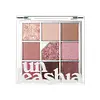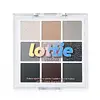What's inside
What's inside
 Key Ingredients
Key Ingredients

 Benefits
Benefits

No benefits
 Concerns
Concerns

 Ingredients Side-by-side
Ingredients Side-by-side

Calcium Titanium Borosilicate
AbrasiveEthylene/Va Copolymer
Emulsion StabilisingBis-Diglyceryl Polyacyladipate-2
EmollientPolybutylene Terephthalate
Acrylates Copolymer
Polyglyceryl-2 Triisostearate
EmulsifyingCI 77891
Cosmetic Colorant1,2-Hexanediol
Skin ConditioningPhenoxyethanol
PreservativeTin Oxide
AbrasiveCI 77491
Cosmetic ColorantSynthetic Fluorphlogopite
Mica
Cosmetic ColorantTalc
AbrasiveSilica
AbrasiveCalcium Aluminum Borosilicate
Nylon-12
Lauroyl Lysine
Skin ConditioningNeopentyl Glycol Diheptanoate
EmollientZinc Stearate
Cosmetic ColorantPhenyl Trimethicone
Skin ConditioningDimethicone
EmollientDiisostearyl Malate
EmollientDipentaerythrityl Hexahydroxystearate/Hexastearate/Hexarosinate
Skin ConditioningMagnesium Myristate
CI 77492
Cosmetic ColorantOctyldodecyl Stearoyl Stearate
EmollientAluminum Myristate
Emulsion StabilisingCI 15850
Cosmetic ColorantTriethoxycaprylylsilane
Ethylhexylglycerin
Skin ConditioningGlyceryl Caprylate
EmollientCI 19140
Cosmetic ColorantMethyl Methacrylate Crosspolymer
Ethylhexyl Palmitate
EmollientCI 77499
Cosmetic ColorantHydrogenated Poly(C6-14 Olefin)
EmollientCaprylic/Capric Triglyceride
MaskingTocopheryl Acetate
AntioxidantDiphenylsiloxy Phenyl Trimethicone
Skin ConditioningPolypropylene
Bis-Behenyl/Isostearyl/Phytosteryl Dimer Dilinoleyl Dimer Dilinoleate
EmollientPetrolatum
EmollientPolyvinyl Acetate
Emulsion StabilisingTrimethylsiloxysilicate
EmollientHydrogenated Polyisobutene
EmollientPalmitic Acid
EmollientPolymethylsilsesquioxane
Dimethicone Crosspolymer
Emulsion StabilisingTrimethylpentanediol/Adipic Acid/Glycerin Crosspolymer
Skin ConditioningCI 77510
Cosmetic ColorantCI 77007
Cosmetic ColorantTridecyl Trimellitate
EmollientCalcium Titanium Borosilicate, Ethylene/Va Copolymer, Bis-Diglyceryl Polyacyladipate-2, Polybutylene Terephthalate, Acrylates Copolymer, Polyglyceryl-2 Triisostearate, CI 77891, 1,2-Hexanediol, Phenoxyethanol, Tin Oxide, CI 77491, Synthetic Fluorphlogopite, Mica, Talc, Silica, Calcium Aluminum Borosilicate, Nylon-12, Lauroyl Lysine, Neopentyl Glycol Diheptanoate, Zinc Stearate, Phenyl Trimethicone, Dimethicone, Diisostearyl Malate, Dipentaerythrityl Hexahydroxystearate/Hexastearate/Hexarosinate, Magnesium Myristate, CI 77492, Octyldodecyl Stearoyl Stearate, Aluminum Myristate, CI 15850, Triethoxycaprylylsilane, Ethylhexylglycerin, Glyceryl Caprylate, CI 19140, Methyl Methacrylate Crosspolymer, Ethylhexyl Palmitate, CI 77499, Hydrogenated Poly(C6-14 Olefin), Caprylic/Capric Triglyceride, Tocopheryl Acetate, Diphenylsiloxy Phenyl Trimethicone, Polypropylene, Bis-Behenyl/Isostearyl/Phytosteryl Dimer Dilinoleyl Dimer Dilinoleate, Petrolatum, Polyvinyl Acetate, Trimethylsiloxysilicate, Hydrogenated Polyisobutene, Palmitic Acid, Polymethylsilsesquioxane, Dimethicone Crosspolymer, Trimethylpentanediol/Adipic Acid/Glycerin Crosspolymer, CI 77510, CI 77007, Tridecyl Trimellitate
Mica
Cosmetic ColorantDimethicone
EmollientHydrogenated Polydecene
EmollientPolyisobutene
Ethylhexyl Palmitate
EmollientMagnesium Myristate
Polyethylene
AbrasiveTocopheryl Acetate
AntioxidantTriethoxycaprylylsilane
Phenoxyethanol
PreservativeEthylhexylglycerin
Skin ConditioningCI 77891
Cosmetic ColorantSynthetic Fluorphlogopite
Silica
AbrasiveNylon-12
Aluminum Hydroxide
EmollientCI 77499
Cosmetic ColorantCI 77491
Cosmetic ColorantCI 77492
Cosmetic ColorantCI 16035
Cosmetic ColorantTin Oxide
AbrasiveCI 77007
Cosmetic ColorantCI 42090
Cosmetic ColorantMica, Dimethicone, Hydrogenated Polydecene, Polyisobutene, Ethylhexyl Palmitate, Magnesium Myristate, Polyethylene, Tocopheryl Acetate, Triethoxycaprylylsilane, Phenoxyethanol, Ethylhexylglycerin, CI 77891, Synthetic Fluorphlogopite, Silica, Nylon-12, Aluminum Hydroxide, CI 77499, CI 77491, CI 77492, CI 16035, Tin Oxide, CI 77007, CI 42090
 Reviews
Reviews

Ingredients Explained
These ingredients are found in both products.
Ingredients higher up in an ingredient list are typically present in a larger amount.
This pigment is called Ultramarine blue lazurite. It gives a saturated blue color, but can be used to create other colors as well.
According to the manufacturer, it is usually made from kaolin, sodium sulfate, sodium carbonate, sulfur, and charcoal.
Ci 77491 is also hydrated iron III oxide. It's sole purpose is to give a red/pink hue to products.
Iron III oxides are classified as inorganic chemicals for coloring.
Synthetically created Ci 77491 is considered safer than those naturally found. This is because the synthetically created version may contain less impurities. Iron oxides are generally non-toxic and non-allergenic.
Learn more about CI 77491Ci 77492 is also hydrated iron III oxide. It's sole purpose is to give a yellow hue to products.
Iron III oxides are classified as inorganic chemicals for coloring.
Synthetically created Ci 77492 is considered safer than those naturally found. This is because the synthetically created version may contain less impurities. Iron oxides are generally non-toxic and non-allergenic.
Learn more about CI 77492Ci 77499 is also hydrated iron III oxide. It is created from mixing red and black iron oxides. This helps give shades of darkness to a product.
Iron III oxides are classified as inorganic chemicals for coloring.
Ci 77891 is a white pigment from Titanium dioxide. It is naturally found in minerals such as rutile and ilmenite.
It's main function is to add a white color to cosmetics. It can also be mixed with other colors to create different shades.
Ci 77891 is commonly found in sunscreens due to its ability to block UV rays.
Learn more about CI 77891Dimethicone is a type of synthetic silicone created from natural materials such as quartz.
What it does:
Dimethicone comes in different viscosities:
Depending on the viscosity, dimethicone has different properties.
Ingredients lists don't always show which type is used, so we recommend reaching out to the brand if you have questions about the viscosity.
This ingredient is unlikely to cause irritation because it does not get absorbed into skin. However, people with silicone allergies should be careful about using this ingredient.
Note: Dimethicone may contribute to pilling. This is because it is not oil or water soluble, so pilling may occur when layered with products. When mixed with heavy oils in a formula, the outcome is also quite greasy.
Learn more about DimethiconeEthylhexyl Palmitate, also known as octyl palmitate, is created from 2-ethylhexyl alcohol and palmitic acid. It is a fatty acid ester.
The fatty acid content of Ethylhexyl Palmitate makes it an emollient. Emollients help soften and hydrate your skin by trapping moisture within.
Ethylhexyl Palmitate is also used to help improve the texture of cosmetics. It helps other ingredient dissolve in products and help disperse ingredients more evenly.
You'll likely find this ingredient in sunscreen, as it is often used to mix UV-blocking ingredients such as avobenzone and ethylhexyl triazone.
It can also help stabilize the fragrances in a product as a fragrance fixative.
Ethylhexyl Palmitate can be used to substitute mineral oil.
Due to its high fatty acid content, it may not be fungal-acne safe.
Learn more about Ethylhexyl PalmitateEthylhexylglycerin (we can't pronounce this either) is commonly used as a preservative and skin softener. It is derived from glyceryl.
You might see Ethylhexylglycerin often paired with other preservatives such as phenoxyethanol. Ethylhexylglycerin has been found to increase the effectiveness of these other preservatives.
We don't have a description for Magnesium Myristate yet.
Mica is a naturally occurring mineral used to add shimmer and color in cosmetics. It can also help improve the texture of a product or give it an opaque, white/silver color.
Serecite is the name for very fine but ragged grains of mica.
This ingredient is often coated with metal oxides like titanium dioxide. Trace amounts of heavy metals may be found in mica, but these metals are not harmful in our personal products.
Mica has been used since prehistoric times throughout the world. Ancient Egyptian, Indian, Greek, Roman, Aztec, and Chinese civilizations have used mica.
Learn more about MicaNylon-12 is a polymer. It is derived from 12-aminododecanoic acid, an omega-amino fatty acid
According to a manufacturer, it is a talc substitute. Like talc, nylon-12 gives products a satin feel. The manufacturer also claims this ingredients does not block pores and has moderate oil absorption.
This ingredient may not be reef-safe.
Learn more about Nylon-12Phenoxyethanol is a preservative that has germicide, antimicrobial, and aromatic properties. Studies show that phenoxyethanol can prevent microbial growth. By itself, it has a scent that is similar to that of a rose.
It's often used in formulations along with Caprylyl Glycol to preserve the shelf life of products.
Silica, also known as silicon dioxide, is a naturally occurring mineral. It is used as a fine, spherical, and porous powder in cosmetics.
Though it has exfoliant properties, the function of silica varies depending on the product.
The unique structure of silica enhances the spreadability and adds smoothness, making it a great texture enhancer.
It is also used as an active carrier, emulsifier, and mattifier due to its ability to absorb excess oil.
In some products, tiny microneedles called spicules are made from silica or hydrolyzed sponge. When you rub them in, they lightly polish away dead skin layers and enhance the penetration of active ingredients.
Learn more about SilicaSynthetic Fluorphlogopite is the synthethic version of mica. It consists of fluorine, aluminum and silicate.
Synthetic Fluorphlogopite is used to add volume to products.
It is considered non-irritating on the skin.
Learn more about Synthetic FluorphlogopiteTin Oxide is an inorganic oxide used to add opacity and volume to a product. In nature, it is already found in mineral form. The main ore of tin is an opaque and shiny mineral called casseterite.
Tin Oxide helps remove translucency in a product, or make it more opaque. Besides adding opacity, tin oxide is used for bulking to add volume.
Tocopheryl Acetate is AKA Vitamin E. It is an antioxidant and protects your skin from free radicals. Free radicals damage the skin by breaking down collagen.
One study found using Tocopheryl Acetate with Vitamin C decreased the number of sunburned cells.
Tocopheryl Acetate is commonly found in both skincare and dietary supplements.
Learn more about Tocopheryl AcetateTriethoxycaprylylsilane is a silicone used to bind and stabilize ingredients.
As an emulsifier, it helps prevent ingredients from separating. This can help elongate the shelf life of products.
Triethoxycaprylylsilane is often used to coat mineral sunscreens ingredients to help give a better feel. It also helps reduce oxidative stress in sunscreens.
Learn more about Triethoxycaprylylsilane